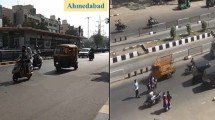Abstract
The phenomenon that pedestrians do not walk in the crosswalk during pedestrian green is defined as overflow violation, which is illegal but common. Broadly varying crossing positions at far-side cross-section may result in widely distributed conflict points with left-turning and right-turning vehicles, which may cause the occurrence of severe conflicts. This paper proposes a model to estimate the overflow pedestrians’ crossing positions at the far-side cross-section of signalized crosswalk, which enables us to better understand pedestrian overflow violation behavior and finally facilitate their safety. After analysis, the intersection geometry and destination are determined as the critical factors causing pedestrians to overflow. And then, Weibull distribution is employed to describe the stochastic characteristics of overflow pedestrians’ crossing position distribution at the far-side cross-section. A crossing position distribution model which takes the crosswalk length, width and distance between crosswalk and destination into account is developed. The established model is validated by comparing the observed pedestrian crossing positions with the estimated crossing positions. The validation results suggest that the established model is capable of being adopted to estimate the overflow pedestrians’ crossing positions at far-side cross-section. Based on the model, countermeasure for overflow violation can be put forward to prevent pedestrians from walking outside the crosswalk.
Similar content being viewed by others
References
SUN S J. Behavior & psychology study on pedestrians’ traffic offences at signalized intersections [D]. Beijing: School of Economics and Management, Beijing Jiaotong University, 2007 (in Chinese).
YUAN H W. Pedestrians’ unsafe behavior on traffic psychology [D]. Beijing: School of Transportation, Beijing Jiaotong University, 2006 (in Chinese).
ZHAN G Z. The traffic characteristics and violation analysis of pedestrians at four-way signal intersections [D]. Beijing: College of Metropolitan Transportation, Beijing University of Technology, 2010 (in Chinese).
ZHAO X J. Violation analysis of pedestrians and nonmotor vehicles [D]. Beijing: School of Transportation, Beijing Jiaotong University, 2005 (in Chinese).
ZHOU R G, HORREY W J, YU R F. The effect of conformity tendency on pedestrian road-crossing intentions in China: An application of the theory of planned behavior [J]. Accident Analysis and Prevention, 2009, 41(3): 491–497.
ZHOU R G, HORREYB W J. Predicting adolescent pedestrians’ behavioral intentions to follow the masses in risky crossing situations [J]. Transportation Research Part F, 2010, 13(3): 153–163.
ZHOU Z P, WANG W, REN G, et al. Choice model of pedestrians’ crossing behavior at signalized intersections [J]. Journal of Southeast University: Natural Science Edition, 2013, 43(3): 664–668 (in Chinese).
TURNER A, PENN A. Encoding natural movement as an agent-based system: An investigation into human pedestrian behavior in the built environment [J]. Environment and Planning B: Planning and Design, 2002, 29(4): 473–490.
HELBING D, FARKAS I, VICSEK T. Simulating dynamical features of escape panic [J]. Nature, 2000, 407(6803): 487–490.
HELBING D, MOLNAR P. Social force model for pedestrian dynamics [J]. Physical Review E, 1995, 51(5): 4282–4286.
BLUE V J, ADLER J L. Cellular automata microsimulation for modeling bi-directional pedestrian walkways [J]. Transportation Research Part B, 2001, 35(3): 293–312.
BURSTEDDE C, KLAUCK K, SCHADSCHNEIDER A, et al. Simulation of pedestrian dynamics using a two-dimensional cellular automaton [J]. Physica A, 2001, 295(3): 507–525.
TEKNOMO K. Microscopic pedestrian flow characteristics: Development of an image processing data collection and simulation model [D]. Tohoku: Graduate School of Information Sciences, Tohoku University, 2002.
XI H, SON Y J. Two-level modeling framework for pedestrian route choice and walking behaviors [J]. Simulation Modelling Practice and Theory, 2012, 22(3): 28–46.
BOLTES M, SEYFRIED A. Collecting pedestrian trajectories [J]. Neurocomput, 2013, 100(2): 127–133.
ZENG W L, CHEN P, NAKAMURA H, et al. Application of social force model to pedestrian behavior analysis at signalized crosswalk [J]. Transportation Research Part C, 2014, 40(1): 143–159.
ELLIS D, SOMMERLADE E, REID I. Modelling pedestrian trajectory patterns with Gaussian processes [C]//12th IEEE International Conference on Computer Vision Workshops. Kyoto: IEEE, 2009: 1229–1234.
PAPADIMITRIOU E, YANNIS G, GOLIAS J. A critical assessment of pedestrian behavior models [J]. Transportation Research Part F, 2009, 12(3): 242–255.
BROGAN D C, JOHNSON N L. Realistic human walking paths [C]//International Conference on Computer Animation and Social Agents. New Jersey: IEEE, 2003: 94–94.
ZENG W L, CHEN P, NAKAMURA H, et al. Modeling pedestrian trajectory for safety assessment at signalized crosswalks [C]//Proceedings of the 10th International Conference of the Eastern Asia Society for Transportation Studies. Taipei: [s.n.]: 2013: 1–17.
JIANG S, WANG D H, QU Z W, et al. Extraction and calibration of trajectory characteristics of vehicles at intersections [J]. Journal of Southwest Jiaotong University, 2012, 47(5): 784–789 (in Chinese).
Author information
Authors and Affiliations
Corresponding author
Additional information
Foundation item: the National Natural Science Foundation of China (Nos. 51278520 and 51278220)
Rights and permissions
About this article
Cite this article
Cao, N., Chen, Y., Qu, Z. et al. Pedestrian crosswalk overflow violation in China: Characteristics and countermeasure. J. Shanghai Jiaotong Univ. (Sci.) 22, 688–696 (2017). https://doi.org/10.1007/s12204-017-1891-8
Received:
Published:
Issue Date:
DOI: https://doi.org/10.1007/s12204-017-1891-8




